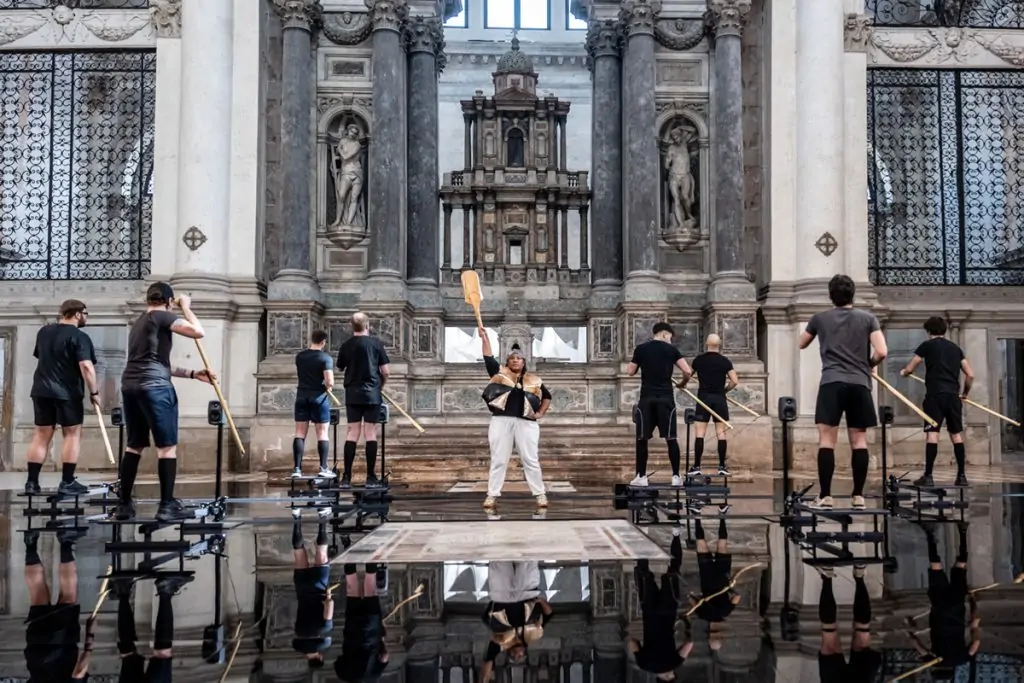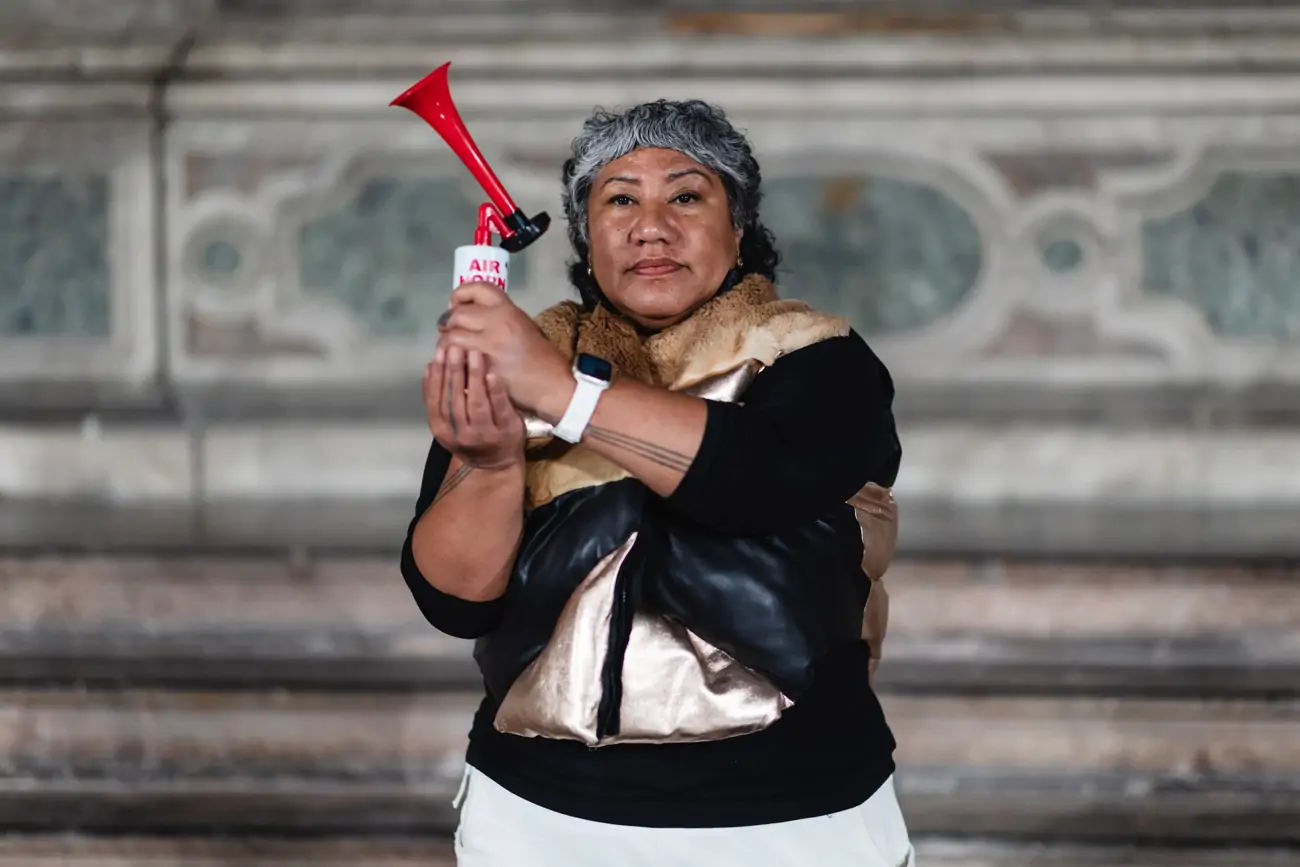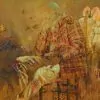Re-Stor(y)ing Oceania curated by Taloi Havini
March 23, 2024 – October 13, 2024
TBA21–Academy
Chiesa di San Lorenzo
Castello 5069, Venice
TBA21–Academy opens Re-Stor(y)ing Oceania at Ocean Space in Venice, an exhibition premiering two site-specific commissions by Indigenous artists from the Pacific, Latai Taumoepeau and Elisapeta Hinemoa Heta.
The exhibition is curated by Bougainville-born, and recent Artes Mundi prize winner, artist Taloi Havini and expands on an ongoing collaboration with TBA21–Academy following her 2021 solo exhibition. Re-Stor(y)ing Oceania is commissioned by TBA21–Academy and Artspace, Sydney, and produced in partnership with OGR Torino, culture and innovation hub.

Re-Stor(y)ing Oceania platforms artists and communities who live and work in the vast and diverse region of islands and atolls in the southern hemisphere. The Pacific Islands are one of the regions most impacted by the damaging effects of climate change, and their Indigenous leaders and communities have led the call for more study and greater awareness of the ensuing crises for decades. Peoples of the Pacific span over a quarter of the planet with ancestral relations that extend from Taiwan, Philippines, Papua New Guinea, Solomon’s, Tonga, Samoa, Fiji to Palau, Hawai’i in the north to the southernmost island of Aotearoa, to Rapa Nui in the east and to the west coast of the Australian continent
Despite the formation of many Pacific Island Countries since 1962, the legacies of colonisation still affect Oceanic communities today – socially and economically through the ongoing exploitation of their natural resources. In a time of climate and environmental crisis Re-Stor(y)ing Oceania seeks to subvert this extractive trajectory through art, oratory, song, genealogy, performance, embodied knowledge, and Oceanic cosmological belief systems.
Havini’s curatorial vision is guided by an ancestral call and response method. For the new commissions, Havini has invited artist Latai Taumoepeau to present a call with the work Deep Communion sung in minor (ArchipelaGO, TH IS IS NOT A DRILL) and Wāhine architect Elisapeta Hinemoa Heta to respond to that call with The Body of Wainuiātea.

Deep Communion sung in minor (ArchipelaGO, TH IS IS NOT A DRILL)
Latai Taumoepeau
East Wing
Tongan artist Latai Taumoepeau presents Deep Communion sung in minor (ArchipelaGO, TH IS IS NOT A DRILL), an immersive 16 channel sound installation inviting the public to engage in a durational performance – bringing global awareness to the dangers of deep-sea mining in the Pacific.
Through the construction of an amphitheatre comprised of sound and standing paddle machines, the artwork references mass congregational worship and layers the geopolitical players amongst cultural complexities surrounding spiritual belief and ritualistic practices through faiva (body-centred) durational performances. Honouring the ancient ceremonial practice of the Me’etu’upaki performed in Tongatapu earlier this year, Taumoepeau invites members of the public to join her as an invocation seeking guidance towards the collective care and protection of Moana (Oceania).
The immersive installation is Taumoepeau’s rendition of an ancient choral ritual, the Me’etu’upaki; (me’e) translates as dance; (tu’u) standing, (paki) with paddles. As the public commits in groups to power the standing paddle machines they amplify Taumoepeau’s people’s ceremonial Me’etu’upaki, their teamwork contributing to the resistance to deep-sea mining (DSM). At the heart of this work is an ancient cultural obligation to keep the cosmogony of the artist’s Tongan ancestors alive over vā (space/time) where Kele (sea sediment) and Limu (seaweed) remain unharmed. Taumoepeau asks the question, who is willing to do the labour in this exercise of ecological responsibility?

The Body of Wainuiātea
Elisapeta Hinemoa Heta
West Wing
The Body of Wainuiātea by Elisapeta Hinemoa Heta presents a new installation embodying ritual and ceremony guided by the Māori concepts of kawa and tikanga from her ancestral lands of Aotearoa New Zealand. Heta is a Māori, Samoan and Tokelauan leader and advocate for change, whose work provides Maori and Pasifika perspectives on the importance of place to design and cultural identity, in connection with whenua (land). Heta’s practice creates spaces and experiences that make visible stories, many of which have been hidden with a focus on Indigenous and Wāhine (women’s) voices.
The Body of Wainuiātea is composed of karanga (Māori women’s spiritual call), gourds, coconut oil fragrance, timber, bricks, textile and stainless steel. Earthen bricks are laid in a formation speaking to ancient ceremonial sites for acknowledging atua (gods). This Ātea is specifically designed by Heta to encourage visitors to acknowledge Wainuiātea and bring their own ancestors with them into these ceremonial grounds.
The sixteen seats are positioned in relation to the cardinal directions, —the rising and setting of the sun. Above, twelve rolling folds of fabric honor Ranginui/Rangi/Lagi and the twelve levels of the heavens. A karanga (Māori women’s spiritual call) composed and sung by Rhonda Tibble will be heard in ritual occasions to honor Moana (Oceania) as tapu (sacred).
Derived from the word “tika,” which means the right or correct way, tikanga is a definition of what is correct to maintain balance in our relationships to both human worlds and the environment. Visitors are invited to enter The Body of Wainuiātea in order to learn, share and reconnect to ancestral stories.
A series of conversations, performances and activities will be programmed in this space over the duration of the exhibition, inviting contributions from multi-disciplinary practitioners. As one enters The Body of Wainuiātea, we are consciously making a decision to bridge the gap between the individual and the collective, the private and the public—to experience sitting in relationality with our neighbours.
Program
Havini is joined by a curatorium, working closely together to produce public programmes centring Indigenous perspectives from across Oceania, Australia, Asia-Pacific, and its diasporas. These gatherings will provide a space for exchanges and conversations, including three days of live performances held over the Venice Biennale vernissage week (16–20 April, 2024), and will remain accessible online, creating a new archive of stories and contributions by First Nations artists, curators, writers, community leaders, poets, musicians, navigators, sailors, fisherfolk and scholars, expanding on the current understandings of our Ocean.
Working alongside Heta and Taumoepeau, collaborating artists, academics, activists, scientists, knowledge holders and family members share through public programs and TBA21–Academy’s online learning initiative OCEAN / UNI, how communities in Oceania navigate the challenges of our contemporary moment – including histories of colonisation, migration, militarism, radiation, extraction, and climate change. The exhibition will be accompanied in the Ocean Space research room by Climate Crisis and Cultural Loss (2021–2024), a two-part research presentation marking the conclusion of the eponymous research project led by Principal Investigator Ute Meta Bauer at NTU ADM.
First unfolding at Ocean Space, the research inquiry later materialises in another configuration at ADM Gallery, a university gallery under the School of Art, Design, and Media (NTU ADM) at Nanyang Technological University Singapore. Extending connections and conversations seeded during the inaugural cycle of TBA21–Academy’s The Current fellowship program led by Bauer from 2015 to 2018, Climate Crisis and Cultural Loss continues to build archipelagic networks across the Alliance of Small
Island Developing States, deepening existing collaborations with Oceania Centre for Arts, Culture and Pacific Studies in Fiji, and developing new ones further in the South Pacific Ocean, through the art and media non-profit organisation Further Arts in Vanuatu.
Re-Stor(y)ing Oceania curated by Taloi Havini opens on March 23, 2024 until October 13, 2024 at Chiesa di San Lorenzo
©2024 TBA21–Academy





